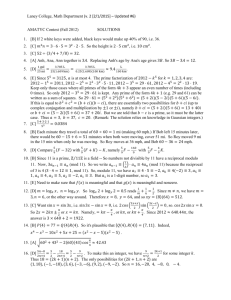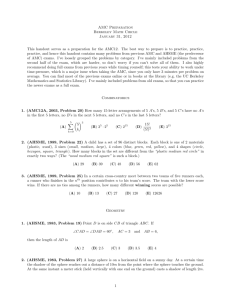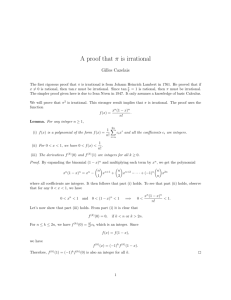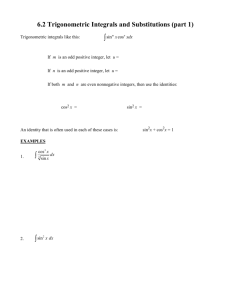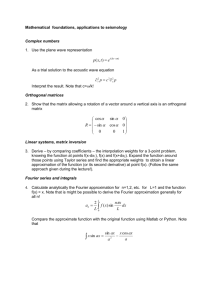ANSWERS TO EXAM 2006-2007
advertisement
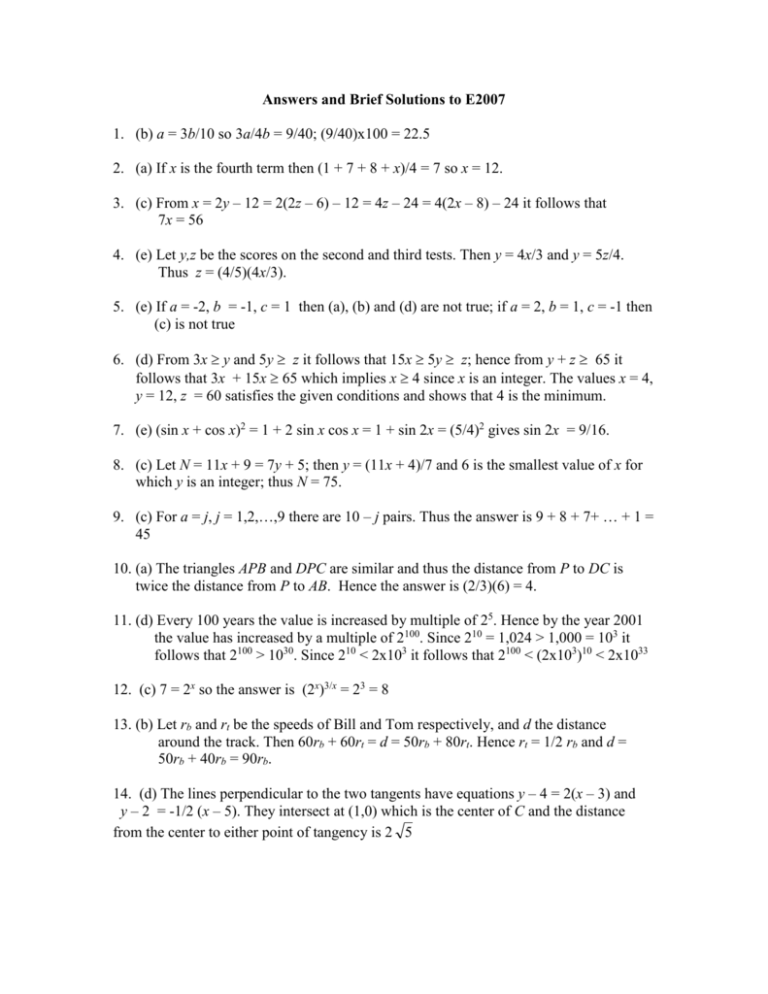
Answers and Brief Solutions to E2007 1. (b) a = 3b/10 so 3a/4b = 9/40; (9/40)x100 = 22.5 2. (a) If x is the fourth term then (1 + 7 + 8 + x)/4 = 7 so x = 12. 3. (c) From x = 2y – 12 = 2(2z – 6) – 12 = 4z – 24 = 4(2x – 8) – 24 it follows that 7x = 56 4. (e) Let y,z be the scores on the second and third tests. Then y = 4x/3 and y = 5z/4. Thus z = (4/5)(4x/3). 5. (e) If a = -2, b = -1, c = 1 then (a), (b) and (d) are not true; if a = 2, b = 1, c = -1 then (c) is not true 6. (d) From 3x y and 5y z it follows that 15x 5y z; hence from y + z 65 it follows that 3x + 15x 65 which implies x 4 since x is an integer. The values x = 4, y = 12, z = 60 satisfies the given conditions and shows that 4 is the minimum. 7. (e) (sin x + cos x)2 = 1 + 2 sin x cos x = 1 + sin 2x = (5/4)2 gives sin 2x = 9/16. 8. (c) Let N = 11x + 9 = 7y + 5; then y = (11x + 4)/7 and 6 is the smallest value of x for which y is an integer; thus N = 75. 9. (c) For a = j, j = 1,2,…,9 there are 10 – j pairs. Thus the answer is 9 + 8 + 7+ … + 1 = 45 10. (a) The triangles APB and DPC are similar and thus the distance from P to DC is twice the distance from P to AB. Hence the answer is (2/3)(6) = 4. 11. (d) Every 100 years the value is increased by multiple of 25. Hence by the year 2001 the value has increased by a multiple of 2100. Since 210 = 1,024 > 1,000 = 103 it follows that 2100 > 1030. Since 210 < 2x103 it follows that 2100 < (2x103)10 < 2x1033 12. (c) 7 = 2x so the answer is (2x)3/x = 23 = 8 13. (b) Let rb and rt be the speeds of Bill and Tom respectively, and d the distance around the track. Then 60rb + 60rt = d = 50rb + 80rt. Hence rt = 1/2 rb and d = 50rb + 40rb = 90rb. 14. (d) The lines perpendicular to the two tangents have equations y – 4 = 2(x – 3) and y – 2 = -1/2 (x – 5). They intersect at (1,0) which is the center of C and the distance from the center to either point of tangency is 2 5 15. (a) After the transfer to B, B has 13 pounds of water and 2 pounds of salt. The final amount of water in A is 5 + 13y/15 and the amount of salt in A is 2y/15. Set (2y/15)/(5 + y) = 1/20 and solve for y. 16. (c) The two balls can be drawn in A = (n + 5)(n + 4)/2 ways and for B = n(n – 1)/2 of these ways both balls are green. Then B/A 1/2 if n2 11n + 20; the least n is n = 13. 17. (a) We consider all sequences of 0’s and 1’s of length 6 where the first digit is a 1 and the remaining 5 digits include at least four 0’s. There are 5 sequences with four 0’s and 1 with five 0’s giving a total of 6. 18. (b) First replace x by x – 1, then y by y - 2 and finally x by –x and y by –y; the resulting equation is -y – 2 = (-x – 1) 2 which simplifies to y = -x2 - 2x – 3. 19. (c) Let x = 100. Then A = (x + 1)/(2x + 5) = 1/2 - (3/2)/(2x + 5); B = (2x + 3)/(4x + 9) = 1/2 – (3/2)/(4x + 9) and C = (3x – 1)/(6x + 1) = 1/2 - (3/2)/(6x + 1). Thus C > B > A. 20. (a) If k is a positive integer then p(k+1) – p(k) = 2k + 1 + b. Thus 7 = 4 + 1 + b and hence b = 2. Therefore p(4) – p(3) = 6 + 1 + 2 = 9. 21. (b) If x2 = a then x3 = 1 + a, x4 = 1 + 2a, x5 = 2 + 3a,... , x10 = 21 + 34a and 21 + 34a = 100 gives the result. 22. (c) The possible winner sequences are AA, ABA, BAA which have respective probabilities 4/9, 4/27 and 4/27; adding gives the answer 23. (d) B = (3,-1) and C = (-1,3). 24. (d) Method 1: By sketching the graphs of y = x + 1 and y = 2x – 1 it is seen there is only one solution if the graph of y = 2x – 1 is shifted up 3/2 units so that the resulting graph lies above and intersects the graph of y = x + 1 at the single point (1/2,3/2). Method 2: For x –1 the given equation is –x – 1 = -2x + 1 + c which has solution x = 2 + c so there is no solution for x –1 and c > 0. For –1 < x 1/2 the equation x + 1 = -2x + 1 + c has solution x = c/3. For 1/2 < x the equation x + 1 = 2x – 1 + c has solution x = 2 – c; setting c/3 = 2 – c gives c = 3/2. 25. (a) If x 2 then f(x) = -1/2x and if 1.9 < x < 2.1 then -1 < -1/3.8 < f(x) < -1/4.2 < 0. 26. (b) By algebra, y = 7x/(x – 7) and hence x > 7. Since y x it is also seen that x otherwise 1/x + 1/y < 1/7Solutions are (x,y) = (8,56) and (14,14). For other values of x, if 7 < x 14 then y is not an integer. 27. (d) Let G,B respectively be the number of senior girls, boys and T the total number of girls (boys) who attended the dance. Then G/B = 2/3 and (T-B)/(T-G) = 3/7. Dividing the numerators of these fractions by T and letting g = G/T and b = B/T gives g/b = 2/3 and (1 – b)/(1 – g) = 3/7. Solve the equations for g. 28. (d) Let d be the length of the altitude and the angle between the side of length a and the hypotenuse. Then sin = d/a, cos = d/b and hence (d/a)2 + (d/b)2 = 1. Solve for d and apply c2 = a2 + b2 29. (c) This may be observed from the identity n100 + 1 = (n – 1)(n99 + n98 + n97 + … + n + 1) + 2. (Note: n can be any positive integer except 1) 30. (a) Let x3 + 5x2 - 13x – 2 = ( x2 + ax + 1)(x – b) = x3 + (a – b)x2 + (1 – ab)x – b. Then a – b = 5 , 1 – ab = -13 and b = 2 which is satisfied by b = 2, a = 7.
